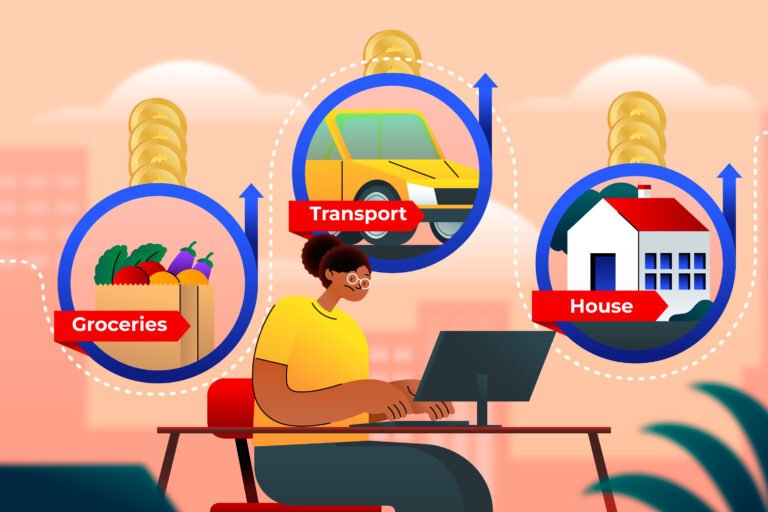1. 💡 What Does “Pay Yourself First” Really Mean?
Shifting the Mindset: From Spending to Saving
Most people approach their income like this: earn money, pay bills, spend on wants, and then save whatever is left—if anything. But “Pay Yourself First” flips that formula. It means the very first thing you do when you receive your paycheck is set aside a portion for your future—whether that’s savings, investments, or retirement.
This mindset treats saving as a non-negotiable priority, not an afterthought. Just like rent, electricity, or groceries, your financial future deserves a spot at the top of your budget.

Table of Contents
Why It’s the Foundation of Financial Wellness
When you pay yourself first, you build habits that protect you from financial stress down the road. Instead of constantly reacting to emergencies or expenses, you’re proactively preparing for them.
Think of it like this: you’re not just earning money to spend—you’re earning to build security, options, and freedom. Over time, these early savings can turn into an emergency fund, a down payment on a house, or a comfortable retirement. That’s why this simple principle is often called the cornerstone of personal finance success.
2. 🧠 The Psychology Behind Paying Yourself First
How Behavioral Finance Supports This Habit
Human brains aren’t naturally wired for long-term financial planning. We crave instant gratification—like a new phone or a dinner out—more than distant rewards like retirement. That’s where behavioral finance comes in. It teaches us that to succeed financially, we must design systems that work with our psychology, not against it.
By paying yourself first, you remove temptation before it even shows up. When savings are automatically deducted before you see your “spendable” income, you don’t feel the urge to spend what’s already out of reach. It’s a simple mental trick that makes a big difference.
The Power of Automating Good Decisions
Automation is your best friend here. Setting up automatic transfers to your savings or investment accounts turns a good intention into a consistent habit. There’s no decision to make each month, no discipline required—just results.
This concept is backed by research: people who automate savings consistently build more wealth over time, regardless of income level. Why? Because they make one smart decision once—and let it run on autopilot.
3. 📊 Step-by-Step Guide to Paying Yourself First
If you’re ready to make this work, here’s a simple roadmap to implement the “Pay Yourself First” strategy:
Step 1: Know Your Net Income
Start with clarity. What is your take-home pay after taxes and mandatory deductions? This is the actual amount you have to work with. Understanding your net income helps set realistic saving goals.
Step 2: Set a Savings Percentage or Target
Decide how much to save each month. A common starting point is 10–20% of your income, but you can start lower and increase over time. The key is consistency, not perfection.
💡 Pro Tip: If your income varies (like freelancers or commission-based workers), choose a percentage instead of a fixed amount.
Step 3: Automate the Transfer
Set up an automatic transfer to a savings, investment, or retirement account as soon as your paycheck arrives. This ensures you save first, not last. Many banks allow you to schedule recurring transfers or split your paycheck into multiple accounts.
Step 4: Build a Budget Around What’s Left
Once you’ve paid yourself, you can now create your budget with the remaining money. Cover essentials like rent, bills, groceries, and then allocate for wants and leisure. This helps you live within your means without sacrificing your savings goals.
4. 🛠️ Tools and Techniques That Help
Turning the “Pay Yourself First” principle into a seamless habit is easier when you use the right tools. Here’s how to set yourself up for success:
High-Interest Savings Accounts
Not all savings accounts are created equal. Choose a high-yield savings account that pays better interest than your standard bank account. This not only grows your money faster but also keeps it slightly “out of reach,” which discourages unnecessary withdrawals.
Budgeting Apps and Automation Tools
Apps like YNAB (You Need a Budget), Mint, or PocketGuard can help you track spending after you’ve paid yourself. Meanwhile, tools like automatic transfers, paycheck split deposits, or round-up apps (e.g., Acorns) help you save in the background without lifting a finger.
Employer-Linked Retirement Plans
If your employer offers a retirement plan (like a 401(k) or provident fund), contribute to it—especially if they match your contributions. These savings happen before your paycheck even hits your account, making it the ultimate “pay yourself first” method.
Separate Savings for Separate Goals
Use multiple savings accounts or “buckets” for different goals: emergency fund, vacation, new car, etc. This adds clarity and helps you avoid raiding one goal to pay for another.
5. 📈 How Much Should You Pay Yourself First?
There’s no one-size-fits-all amount when it comes to saving, but having a clear benchmark can guide your decision. Here’s how to figure out what works for you:
The 50/30/20 Rule (and Variations)
A popular budgeting guideline recommends:
- 50% of your income for needs (rent, utilities, food)
- 30% for wants (entertainment, shopping, etc.)
- 20% for savings and debt repayment
In this model, 20% is your “pay yourself first” amount. You can adjust the rule based on your income, debt level, and goals. Some high savers aim for 30–40%—especially if they want early retirement or rapid wealth building.
Fixed Amount vs. Percentage-Based Saving
You can either:
- Choose a fixed amount each month (e.g., ₨10,000)
- Or save a percentage of each paycheck (e.g., 15%)
For those with a variable income, percentages work better. You’ll stay consistent without overcommitting during lean months.
Adapting the Rule for Variable Income
If your earnings fluctuate:
- Establish a baseline saving percentage (e.g., 10%)
- On higher-income months, increase it to 20–30%
- Create a “buffer fund” to cover expenses when income drops
The key is to save something every month, even if it’s small. Building the habit matters more than the amount at the start.
6. 🔄 Making It Sustainable: Tips for Success
Saving money once is easy—doing it month after month is the real challenge. These strategies will help you stick with the “Pay Yourself First” habit for the long haul:
Start Small and Scale Up
If saving 20% feels impossible right now, don’t stress. Begin with just 1–5%, then increase by 1% every few months. This gradual approach makes the habit stick without disrupting your lifestyle.
Treat It Like a Non-Negotiable Bill
Imagine your savings as a mandatory expense—just like rent or electricity. This mindset shift helps eliminate the option to skip it. Once the money moves out, you’ll naturally adjust your spending to what’s left.
Automate and Forget It
Set up automatic transfers so you don’t have to make the decision every month. When saving is automatic, you remove willpower and procrastination from the equation.
Create Visual Motivation
Track your progress with visual tools: savings goal trackers, progress bars, or apps with achievement badges. Seeing your growth builds momentum and makes the process feel rewarding.
Celebrate Milestones
When you hit a savings milestone—₨50,000, ₨100,000, or your first emergency fund—reward yourself (without breaking your budget). A small celebration reinforces positive habits.
Review and Adjust Periodically
Your income, expenses, and goals will change. Reassess your savings plan every 3–6 months to make sure it still fits your life. Increase savings when you get a raise or reduce expenses.
7. 🚫 Common Mistakes to Avoid
Even with the best intentions, it’s easy to fall into traps that derail your “Pay Yourself First” strategy. Here are some common pitfalls to watch out for—and how to avoid them:
Paying Yourself Last
Many people plan to save “whatever is left” after spending. But let’s be honest—there’s rarely anything left. This approach turns saving into an afterthought instead of a priority. Reverse the order, and make saving the first move, not the last.
Ignoring Irregular Expenses
Forgetting to plan for non-monthly expenses (like car repairs, gifts, or annual insurance premiums) can force you to dip into your savings. Avoid this by creating a sinking fund—small monthly contributions for predictable but irregular costs.
Making It Too Complicated
If your savings system involves too many steps or accounts, you’re less likely to stick with it. Keep it simple: automate, track, and adjust when necessary. Complexity kills consistency.
Withdrawing Savings Too Easily
If your savings are too accessible, it becomes your backup spending account. Move savings to a separate bank, or even use an account without a debit card, to create a little friction and protect your progress.
Not Having a Clear Goal
Saving aimlessly can feel pointless. Define specific goals (e.g., 6-month emergency fund, down payment, vacation, debt freedom). Purpose gives your saving power and keeps you motivated.
8. 🎯 What to Do With the Money You Save
Paying yourself first is just the beginning—what you do with that money matters just as much. Here’s how to put your savings to work:
Build an Emergency Fund
Your first savings goal should be an emergency fund—typically 3 to 6 months of living expenses. This fund protects you from unexpected setbacks like medical bills, job loss, or urgent repairs. Keep it in a high-yield savings account for easy access without temptation.
Tackle High-Interest Debt
Once your emergency fund is in place, consider using your savings to pay off high-interest debt (like credit cards or personal loans). The return on paying off 20–30% interest debt is often better than any investment.
Invest for the Future
After your debt is under control, start investing. Options include:
- Retirement accounts (e.g., pension plans, IRAs)
- Mutual funds or ETFs
- Stock portfolios or real estate
Investing grows your wealth over time and helps your money outpace inflation.
Save for Specific Goals
Whether it’s a car, a wedding, a vacation, or starting a business, assign some of your savings to personal goals. Break large goals into monthly targets and track your progress to stay motivated.
Diversify Your Savings Strategy
Split your savings into short-, medium-, and long-term buckets:
- Short-term: Emergency fund, travel
- Medium-term: House down payment, business fund
- Long-term: Retirement, kids’ education, financial independence
This gives your savings direction and balance.
9. 🧠 Real-Life Examples and Case Studies
How a Freelancer Makes It Work
A freelance graphic designer with a variable monthly income sets aside 25% of each payment into a separate savings account—before paying bills or spending. She automates transfers whenever clients pay and uses an app to track monthly goals. On months when income is low, she dips into a small buffer fund but never touches her long-term savings. Her trick? Treating savings as a non-negotiable “business expense.”
A Couple Balancing Joint and Individual Savings
A married couple manages finances by having both joint and personal accounts. They pay themselves first by transferring 15% of their combined income into a shared savings account for joint goals (like vacations or a home down payment). Individually, each spouse saves 10% of their income in separate accounts for personal goals. This structure keeps them aligned on big goals while maintaining independence and flexibility.
10. ✅ Final Thoughts: Make It a Lifelong Habit
Why This One Habit Can Change Your Future
“Pay Yourself First” may seem simple—but it’s a habit that creates lasting financial freedom. It ensures you’re always moving forward, even in small steps. Over time, those consistent savings lead to opportunity, security, and peace of mind—far more powerful than impulsive spending.
Encouraging Accountability and Long-Term Growth
To stick with it:
- Review your progress regularly
- Celebrate milestones
- Involve a partner, friend, or coach for accountability
- Increase your savings rate over time as income grows
In the end, paying yourself first is more than a budgeting trick—it’s a mindset that says: “My future matters, and I’m investing in it every month.”
Read Also: How to Split Your Paycheck for Maximum Growth and Minimum Regret






